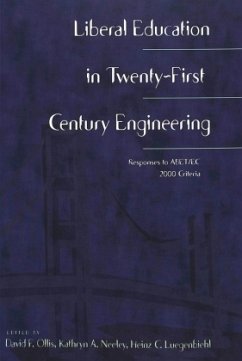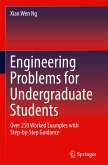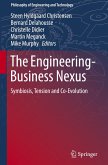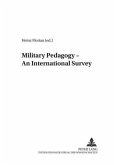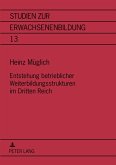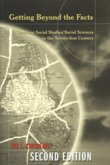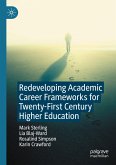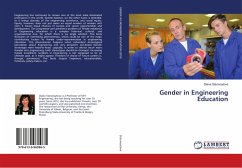Liberal Education in Twenty-First Century Engineering
Responses to ABET/EC 2000 Criteria
Herausgegeben:Ollis, David F.; Neeley, Kathryn A.; Luegenbiehl, Heinz C.
Liberal Education in Twenty-First Century Engineering
Responses to ABET/EC 2000 Criteria
Herausgegeben:Ollis, David F.; Neeley, Kathryn A.; Luegenbiehl, Heinz C.
- Broschiertes Buch
- Merkliste
- Auf die Merkliste
- Bewerten Bewerten
- Teilen
- Produkt teilen
- Produkterinnerung
- Produkterinnerung
Twenty-first century engineering education must meet radically revised national accreditation standards, known colloquially as EC2000. This book shows paths forward for all faculty involved in the "liberal education" of engineering undergraduates. Beginning with an exhortation for liberal education, it includes the EC2000 criteria and its historical origin, as well as example institutional and individual responses to these criteria - which include topics in communication, ethics and professional responsibility, contemporary issues, art and aesthetics, and the integration of engineering and the…mehr
Andere Kunden interessierten sich auch für
![Engineering Problems for Undergraduate Students Engineering Problems for Undergraduate Students]() Xian Wen NgEngineering Problems for Undergraduate Students39,99 €
Xian Wen NgEngineering Problems for Undergraduate Students39,99 €![The Engineering-Business Nexus The Engineering-Business Nexus]() The Engineering-Business Nexus77,99 €
The Engineering-Business Nexus77,99 €![Military Pedagogy - An International Survey Military Pedagogy - An International Survey]() Military Pedagogy - An International Survey71,95 €
Military Pedagogy - An International Survey71,95 €![Entstehung betrieblicher Weiterbildungsstrukturen im Dritten Reich Entstehung betrieblicher Weiterbildungsstrukturen im Dritten Reich]() Heinz MüglichEntstehung betrieblicher Weiterbildungsstrukturen im Dritten Reich54,95 €
Heinz MüglichEntstehung betrieblicher Weiterbildungsstrukturen im Dritten Reich54,95 €![Getting Beyond the Facts Getting Beyond the Facts]() Joe L. KincheloeGetting Beyond the Facts64,80 €
Joe L. KincheloeGetting Beyond the Facts64,80 €![Redeveloping Academic Career Frameworks for Twenty-First Century Higher Education Redeveloping Academic Career Frameworks for Twenty-First Century Higher Education]() Mark SterlingRedeveloping Academic Career Frameworks for Twenty-First Century Higher Education98,99 €
Mark SterlingRedeveloping Academic Career Frameworks for Twenty-First Century Higher Education98,99 €![Gender in Engineering Education Gender in Engineering Education]() Diana StarovoytovaGender in Engineering Education58,99 €
Diana StarovoytovaGender in Engineering Education58,99 €-
-
-
Twenty-first century engineering education must meet radically revised national accreditation standards, known colloquially as EC2000. This book shows paths forward for all faculty involved in the "liberal education" of engineering undergraduates. Beginning with an exhortation for liberal education, it includes the EC2000 criteria and its historical origin, as well as example institutional and individual responses to these criteria - which include topics in communication, ethics and professional responsibility, contemporary issues, art and aesthetics, and the integration of engineering and the humanities. The variety of curricular responses presented indicate that this is a formative - perhaps even revolutionary - period in engineering education.
Produktdetails
- Produktdetails
- Worcester Polytechnic Institute (WPI Studies) 23
- Verlag: Peter Lang
- Artikelnr. des Verlages: 64924
- 1. Auflage
- Seitenzahl: 386
- Erscheinungstermin: 5. Januar 2004
- Englisch
- Abmessung: 225mm x 150mm x 21mm
- Gewicht: 520g
- ISBN-13: 9780820449241
- ISBN-10: 0820449245
- Artikelnr.: 24521887
- Herstellerkennzeichnung
- Lang, Peter GmbH
- Gontardstraße 11
- 10178 Berlin
- r.boehm-korff@peterlang.com
- Worcester Polytechnic Institute (WPI Studies) 23
- Verlag: Peter Lang
- Artikelnr. des Verlages: 64924
- 1. Auflage
- Seitenzahl: 386
- Erscheinungstermin: 5. Januar 2004
- Englisch
- Abmessung: 225mm x 150mm x 21mm
- Gewicht: 520g
- ISBN-13: 9780820449241
- ISBN-10: 0820449245
- Artikelnr.: 24521887
- Herstellerkennzeichnung
- Lang, Peter GmbH
- Gontardstraße 11
- 10178 Berlin
- r.boehm-korff@peterlang.com
The Editors: David F. Ollis, Distinguished Professor of Chemical Engineering at North Carolina State University, is a past program chair and division chair of the Liberal Education Division (LED) of the American Society for Engineering Education (ASEE). Kathryn A. Neeley, Associate Professor of Technology, Communication and Culture at the School of Engineering, University of Virginia, is past chair of both LED/ASEE and the Humanities and Technology Association, and author of Mary Somerville: Science, Illumination, and the Female Mind (2001). Heinz C. Luegenbiehl, Head of Humanities and Social Sciences, and Professor of Philosophy and Technology Studies at Rose-Hulman Institute of Technology in Terre Haute, Indiana, is a former chair of LED/ASEE and vice president of the Humanities and Technology Association, and has held various visiting professorships, most recently at Kanazawa Institute of Technology in Japan.
Contents: Samuel C. Florman: Prologue: The Civilized Engineer - Edward Alton Parrish: Liberal Education and Engineering Criteria 2000 - Lance Schachterle: Liberal Education Responds: Discussing ABET 2000 within a Humanities Division - Carolyn R. Miller: Reuniting Wisdom and Eloquence within the Engineering Curriculum - Kathryn A. Neeley: To Arrive Where We Started and Know the Place for the First Time? Re-visioning Technical Communication - Leslie Perelman: Creating a Communication-intensive Undergraduate Curriculum in Science and Engineering for the Twenty-first Century - John Brown: Refashioning the First-year Introductory Course on Communication Skills and Engineering Practice - Charles C. Adams: The Role of the Humanities in Distinguishing Science from Engineering Design in the Minds of Engineering Students - Heinz C. Luegenbiehl/Donald L. Decker: The Role of Values in Teaching Design - Heinz C. Luegenbiehl: Engineering Ethics Education for the Twenty-first Century: Topics for Exploration - Joseph R. Herkert: Integrating Engineering, Ethics, and Public Policy: Three Examples - Michael E. Gorman/Julie M. Stocker/Matthew M. Mehalik: Using Detailed, Multimedia Cases to Teach Engineering Ethics - Edward Wenk, Jr.: Teaching Engineering as a Social Science - Craig Gunn: Orienting Engineering Students to Contemporary Issues through a Broader Perspective - John Krupczak: Reaching Out across Campus: Engineers as Champions of Technological Literacy - Ann Brown: The Museum in the Classroom: Technology in Art - Kathryn A. Neeley: The Aesthetics of Engineering: Toward an Integrated View of Engineering Design - Barbara M. Olds/Ronald L. Miller: Integrating Humanities and Engineering: Two Models for Achieving ABET Criteria 2000 Goals - Heinz C. Luegenbiehl: Responding to ABET 2000: A Process Model for the Humanities and Social Sciences - Joseph R. Herkert: STS for Engineers: Integrating Engineering, Humanities, and Social Sciences through STS Courses and Programs - Scot Douglass: Teaching Students, Not Texts: The Utility of the Humanities in Fulfilling ABET 2000 Criteria - Ann Brown/Steve Luyendyk/David F. Ollis: Implementing an English and Engineering Collaboration - Marshall M. Lih: The Parable of Baseball Engineering - Joseph R. Herkert: A Multidisciplinary Course on Technological Catastrophes - Charles W. N. Thompson: Prolegomena for Evaluation of Multidisciplinary Student Teams - John P. O'Connell/Mark A. Shields/Eugene R. Seeloff/Timothy C. Scott/Brian Pfaffenberger: Professional Development at the University of Virginia: Attributes, Experiences, ABET 2000 and an Implementation - O. Allan Gianniny, Jr.: A Century of ASEE and Liberal Education (or How Did We Get Here from There, and Where Does It All Lead?).
Contents: Samuel C. Florman: Prologue: The Civilized Engineer - Edward Alton Parrish: Liberal Education and Engineering Criteria 2000 - Lance Schachterle: Liberal Education Responds: Discussing ABET 2000 within a Humanities Division - Carolyn R. Miller: Reuniting Wisdom and Eloquence within the Engineering Curriculum - Kathryn A. Neeley: To Arrive Where We Started and Know the Place for the First Time? Re-visioning Technical Communication - Leslie Perelman: Creating a Communication-intensive Undergraduate Curriculum in Science and Engineering for the Twenty-first Century - John Brown: Refashioning the First-year Introductory Course on Communication Skills and Engineering Practice - Charles C. Adams: The Role of the Humanities in Distinguishing Science from Engineering Design in the Minds of Engineering Students - Heinz C. Luegenbiehl/Donald L. Decker: The Role of Values in Teaching Design - Heinz C. Luegenbiehl: Engineering Ethics Education for the Twenty-first Century: Topics for Exploration - Joseph R. Herkert: Integrating Engineering, Ethics, and Public Policy: Three Examples - Michael E. Gorman/Julie M. Stocker/Matthew M. Mehalik: Using Detailed, Multimedia Cases to Teach Engineering Ethics - Edward Wenk, Jr.: Teaching Engineering as a Social Science - Craig Gunn: Orienting Engineering Students to Contemporary Issues through a Broader Perspective - John Krupczak: Reaching Out across Campus: Engineers as Champions of Technological Literacy - Ann Brown: The Museum in the Classroom: Technology in Art - Kathryn A. Neeley: The Aesthetics of Engineering: Toward an Integrated View of Engineering Design - Barbara M. Olds/Ronald L. Miller: Integrating Humanities and Engineering: Two Models for Achieving ABET Criteria 2000 Goals - Heinz C. Luegenbiehl: Responding to ABET 2000: A Process Model for the Humanities and Social Sciences - Joseph R. Herkert: STS for Engineers: Integrating Engineering, Humanities, and Social Sciences through STS Courses and Programs - Scot Douglass: Teaching Students, Not Texts: The Utility of the Humanities in Fulfilling ABET 2000 Criteria - Ann Brown/Steve Luyendyk/David F. Ollis: Implementing an English and Engineering Collaboration - Marshall M. Lih: The Parable of Baseball Engineering - Joseph R. Herkert: A Multidisciplinary Course on Technological Catastrophes - Charles W. N. Thompson: Prolegomena for Evaluation of Multidisciplinary Student Teams - John P. O'Connell/Mark A. Shields/Eugene R. Seeloff/Timothy C. Scott/Brian Pfaffenberger: Professional Development at the University of Virginia: Attributes, Experiences, ABET 2000 and an Implementation - O. Allan Gianniny, Jr.: A Century of ASEE and Liberal Education (or How Did We Get Here from There, and Where Does It All Lead?).

